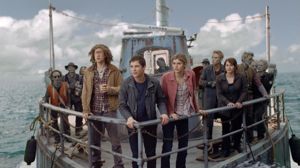It’s not easy creating a magical world where modernity and Greek myth co-exist (not to mention live-action and computer animation), but you did a great job on Percy Jackson: Sea of Monsters. It didn’t hurt that you helmed a solid crew that included Rhythm & Hues Studios animators who recently earned Life of Pi a Best Visual Effects Oscar. Your experience working on blockbusters like Rise of the Planet of the Apes and Night at the Museum certainly helped as well. But what surprised me most was that, despite the film’s being a relentless 3D visual extravaganza, your work didn’t detract from characters and plot. Contemporary teenage movies often rely on bombastic visual effects for entertainment with the end result soulless. How Sea of Monsters evaded that trap is intriguing.
You seem to know when to kick back and let others do their thing. In this sequel to The Lightning Thief – the first adaptation of author Rick Riordan’s YA series Percy Jackson & the Olympians – you left room for director Thor Frudenthal to focus on young demigod Percy’s coming of age. This made the movie more powerful than its predecessor, in which meaning was lost. In Sea of Monsters, Percy embarks on a journey to find the Golden Fleece that could save Camp Half-Blood, a demigod training centre, from destruction by Hermes’ rebellious son Luke. Along the way, Percy and his band of young heroes test their powers and limitations; they face their demons and mature. Recurring are the travails of parent-child relations: Percy feels abandoned by his father the Sea God Poseidon, and Luke’s fury towards elusive Hermes pushes him to commit evil acts. Parents and young viewers will both relate to this topic.
The film’s footing in Greek myth provided a golden opportunity for you and your crew to show off your talents. Magical Hippocampus, half-horse and half-fish, was impressive with dazzling pink and green scales that recalled a Monet water lily painting. The Oracle of Delphi was an original robot with incandescent eyes whose narration of the legend of Kronos – the King of the Titans who ate his own children – was told in a spellbinding stained-glass animated sequence. It was an ingenious way to tell a brutal story without getting too graphic. These clever circumventions of gratuitous violence are present throughout the film, making it totally kid-friendly.
But the film had some glitches. The Gray Sisters’ taxi stunts, for instance, were overwrought and interrupted the movie’s flow. Polyphemus, played by 6-foot-10 Acadian boxer Robert Maillet, was disappointing. Supposed to be one of the film’s deadliest monsters, in the end his role was negligible. This was unfortunate since Maillet’s imposing stature and charisma made him perfect for the part. With these inconsistencies, the Percy Jackson film series has yet to show it can live up to mega-hits like Pirates of the Caribbean or Harry Potter.
Claude, you were nonetheless able to create a world that was both fantastic and believable. You supported Frudenthal’s emphasis on the very relevant and relatable growing pains of teenage gods, which made Sea of Monsters more substantial than The Lightning Thief. The series is on the comeback trail; families should enjoy this latest edition.
Surprisingly Entertained,
Katherine







